Unit 7 - Every move you make
Content
Scheme of work
10u7.1 - Motion and Kinematics
This unit explores how things move, both in our everyday world and inside living organisms. Just as we use transport systems to move people and goods, our bodies have transport systems too. In this lesson, we begin by examining physical motion in the real world through the lens of physics.
What is motion?
Motion is the change in position of an object over time. Understanding motion allows us to describe how fast, in what direction, and for how long an object is moving.
- Motion can be described in terms of speed, velocity, and acceleration
- Kinematics is the branch of physics that describes motion without looking at forces
- Distance is a scalar quantity, but displacement is a vector
Different types of motion in physics

Describing motion with graphs
We can represent motion using graphs - such as distance-time and velocity-time graphs. These help us analyse changes in speed, acceleration, and direction.
Example
A horizontal line on a distance-time graph means constant speed. A steep line means the object is moving faster.
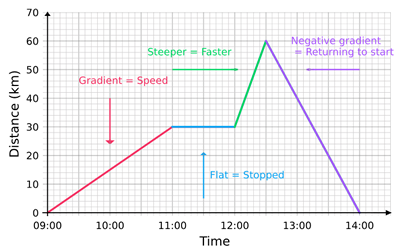
Distance-time graph
Graph interpretation game
Give each student or pair a graph and ask them to write a short description of the motion it represents. Then, students read their descriptions aloud while others guess which graph it describes. Optionally, ask them to sketch the graph based on a peer's description.
Why is this important?
Understanding physical motion prepares us to analyse biological motion later in this unit — from muscles to blood and plant transport. It also helps us link what we learn in science to everyday technologies and transport systems.
Summary
- Motion describes how objects change position over time
- Kinematics focuses on speed, velocity, and acceleration without discussing forces
- Graphs are powerful tools for visualising motion
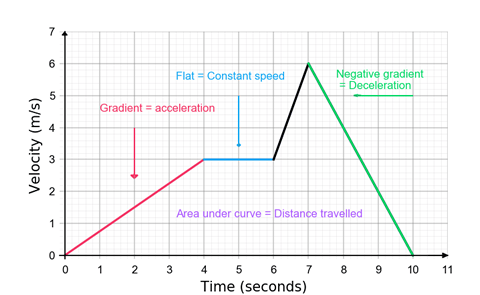
Velocity-time graph
Check your understanding
- What is the difference between distance and displacement?
- What does the slope of a distance-time graph represent?
- Why do we use graphs to represent motion?
10u7.2 – Kinematic equations
In the previous lesson, we explored how motion can be described and visualised using graphs. Now we go further and learn how to calculate motion using **kinematic equations** — formulas that relate velocity, acceleration, time, and displacement.
Key quantities and units
- Distance (s) – how far something travels (m)
- Velocity (v or u) – speed in a direction (m/s)
- Acceleration (a) – change in velocity per second (m/s²)
- Time (t) – duration (s)
Kinematic equations
- a = (v - u) / t — acceleration
- v = u + at — final velocity
- s = ut + ½at² — displacement
- v² = u² + 2as — no time
Example 1 – Acceleration
A car increases its speed from 10 m/s to 30 m/s in 5 seconds. What is the acceleration?
a = (v - u) / t = (30 - 10) / 5 = 4 m/s²
Example 2 – Finding distance
A motorbike starts from rest (u = 0) and accelerates at 2 m/s² for 6 seconds. How far does it travel?
s = ut + ½at² = 0 + 0.5 × 2 × 6² = 36 m
Example 3 – No time
A stone is thrown upwards at 20 m/s. How high does it go before it stops? (Assume a = -10 m/s²)
v² = u² + 2as → 0² = 20² + 2 × (-10) × s
→ s = 20 m
Using graphs and simulations
You can also interpret or generate motion data from distance-time and velocity-time graphs, and compare it with calculations using these equations. Try the interactive link below:
Practical motion analysis
Have students measure the time it takes to walk or run a set distance, or roll a marble down a slope. Use sensors, phones, or timers to gather data. Then apply the kinematic equations to calculate acceleration or final velocity. Compare to motion graphs.
Summary
- Kinematic equations link speed, acceleration, time, and displacement
- They help us solve real-world motion problems
- Experiments and graphs help visualise and confirm the maths
Check your understanding
- What is the formula for acceleration?
- A runner accelerates from 0 to 8 m/s in 4 seconds. What is their acceleration?
- Which equation would you use to calculate displacement without knowing time?
Using a ticker timer to find acceleration
The ticker timer marks a strip of paper with one dot every 0.02 seconds. Hence 10 dots represents 0.2 seconds.
Measuring the distance travelled by 10 dots of the tape, attached to a trolley gives the velocity at that time. If we know the final velocity, the initial velocity and the total time (from all of the dots) we can determine the acceleration.
10u7.3 – Newton’s Laws
Previously, we learned how to describe motion using kinematic equations. In this lesson, we explore what causes motion — forces — and how Newton’s laws of motion describe the way objects behave when forces act on them.
What is a force?
A force is a push or a pull that can cause an object to move, stop, or change direction. It is measured in newtons (N).
Activity: Pushes and pulls
PhET Simulation – this is a revision activity that was covered in MYP9u5 Forces and Motion Basics
Follow the instructions in the worksheet
- Forces can cause acceleration (change in motion)
- They act in pairs and have direction and magnitude
- Examples: gravity, friction, air resistance, applied force
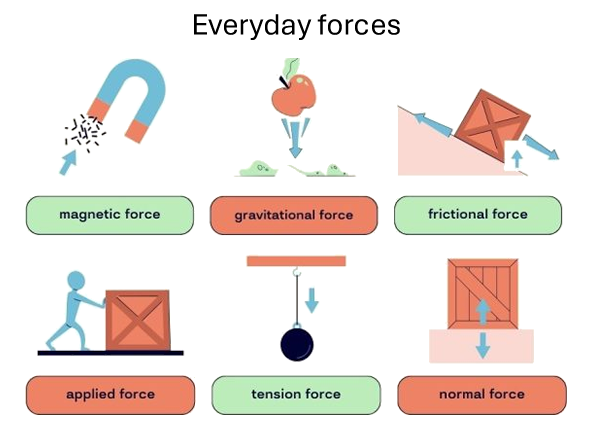
Newton’s first law:– Inertia
An object at rest will stay at rest, and an object in motion will stay in motion at constant velocity unless acted upon by an unbalanced force.
Example:– First Law
A book lying on a table will not move unless pushed. If you slide it, it will keep moving — unless friction slows it down.
Newton’s second law:– F = ma
When an unbalanced force acts on an object, it causes the object to accelerate. The acceleration depends on the object's mass and the size of the force.
F = ma
Example:– Second Law
A 2 kg object is pushed with a force of 6 N. What is its acceleration?
a = F / m = 6 / 2 = 3 m/s²
Newton’s third law:– Action and reaction
For every action, there is an equal and opposite reaction. Forces always act in pairs.
Example:– Third Law
When a swimmer pushes back on the water with their hands, the water pushes them forward with an equal and opposite force.
Energy and work
When a force causes movement, energy is transferred and work is done. We also relate force to power and efficiency in real-world motion.
- Work = Force × Distance
- Power = Work / Time
Activity: Newton’s law stations
Set up mini-labs or demos around the room: friction ramp, balloon rockets, push-pull spring scales.
Students rotate in groups and observe or measure the effects of forces. Include a stairs experiment for calculating work done and power.
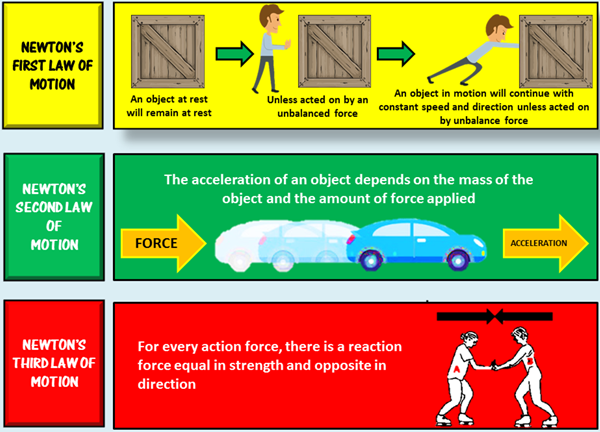
Newton’s three laws of motion
Summary
- Forces cause objects to start moving, stop, or change direction
- Newton’s three laws describe how motion changes when forces act
- We can calculate force, acceleration, work, and power using equations
Check your understanding
- What does Newton’s first law say about motion and forces?
- A 4 kg cart accelerates at 2 m/s². What is the force applied?
- Give an example of Newton’s third law in everyday life.
10u7.4 – Biological Transport
Complex biological systems depend on many chemical reactions occurring in multicellular organisms. These chemical reactions employ essential nutrients and make waste products that must be removed from the cells. This requires transport.
Plants and animals have complex transport systems to bring nutrients to all parts of the organism and to remove waste products.
Simple organisms, such as unicellular species, can rely on diffusion for these processes.
Why do we need transport systems?
Multicellular organisms are too large for diffusion alone to supply all cells quickly. Transport systems move substances efficiently throughout the body.
In animals
- Transport ensures oxygen reaches cells for respiration
- Removes waste like carbon dioxide and urea
- Distributes nutrients from digestion
10u7.5 – The Circulatory System
In the previous lessons, we explored how forces and motion affect physical systems. Now we turn to the human body and examine how it transports essential materials such as oxygen, nutrients, and waste — a complex and efficient biological transport system.
Biomechanics supports movement and to power those movements, our cells need oxygen and nutrients. In this lesson, we explore how the circulatory system delivers these essentials throughout the body.
What is the circulatory system?
This system transports oxygen, nutrients, hormones, and waste products via the blood. It is composed of the heart, blood, and blood vessels, and is sometimes called the cardiovascular system.
- Transports substances efficiently throughout the body
- Maintains temperature and pH balance
- Helps protect the body through immune responses
Structure of the circulatory system
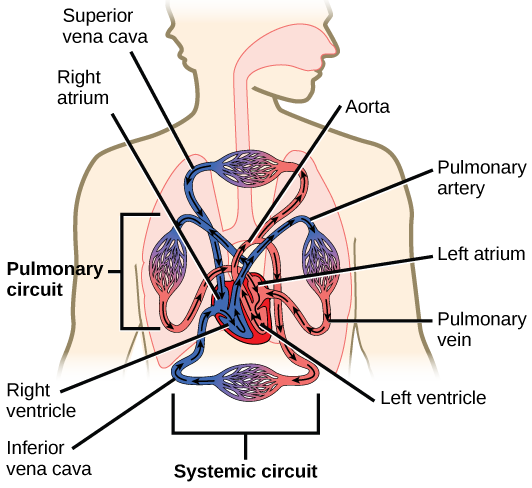
Heart rate and activity
Heart rate increases during physical activity to meet the body's rising oxygen demand. This allows muscles to carry out more aerobic respiration.
Example – Heart rate experiment
Students measure resting heart rate, do light exercise (e.g. star jumps), and measure again. Compare recovery time and relate this to fitness levels and oxygen demand.
Blood as a transport fluid
- Red blood cells – carry oxygen using haemoglobin
- Plasma – carries nutrients, hormones, and waste
- White blood cells – fight infection
- Platelets – help blood clot
Components of blood
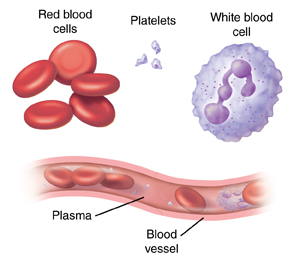
Blood vessels
- Arteries – carry blood away from the heart (high pressure)
- Veins – return blood to the heart (valves prevent backflow)
- Capillaries – tiny vessels for gas and nutrient exchange
Types of blood vessels
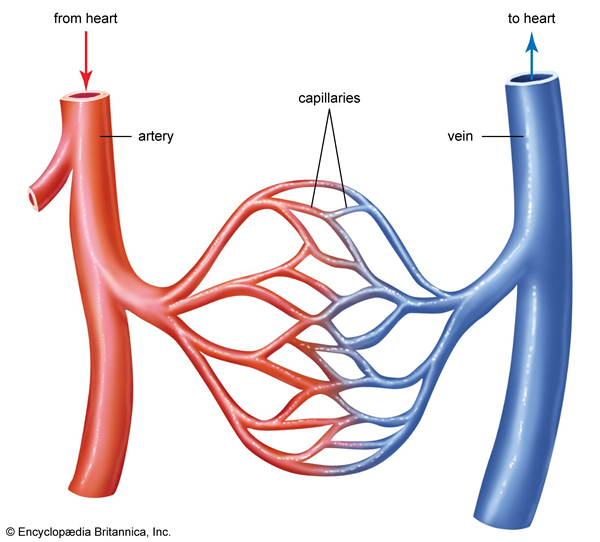
Pulse and exercise
Heart rate increases during exercise to deliver more oxygen to the muscles. Pulse is the rhythmic beat felt in arteries as the heart pumps.
Heart rate recovery period
In pairs, students take resting pulse, perform exercise (e.g. running on the spot for 1 min), then take pulse again every 30 seconds until back to normal. Plot a graph of recovery and compare fitness levels.
Discuss how this links to biological transport and respiration.
Summary
- Transport systems move essential substances around the body
- Blood and blood vessels form the transport network
- Heart rate increases with activity to meet energy demand
The heart – a double pump
The heart pumps blood in two loops: to the lungs (pulmonary circulation) and to the rest of the body (systemic circulation).
Example – Pathway of blood
Blood enters the right atrium → right ventricle → lungs → left atrium → left ventricle → rest of body.
The double circulatory system
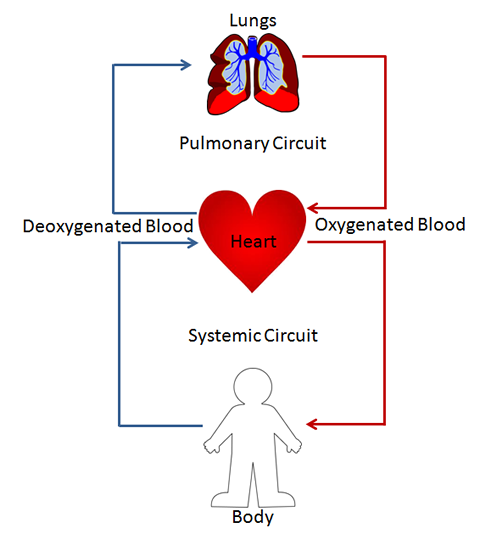
Types of blood vessels
- Arteries – thick walls, high pressure, carry blood away from the heart
- Veins – thinner walls, lower pressure, valves prevent backflow
- Capillaries – very small, exchange gases and nutrients with cells
Activity: Heart model and blood flow
Build a working model of the heart using plastic tubing, syringes, and water with food colouring.
Label chambers and demonstrate valves and flow direction.
Alternatively, use diagrams or online simulations to trace blood flow.
Summary
- The circulatory system moves oxygen, nutrients, and waste around the body
- The heart pumps blood in a double circuit
- Blood vessels have specialised structures for different functions
Check your understanding
- What are the two main circulatory loops called?
- How does blood flow through the heart?
- Why does heart rate increase during exercise?
10u7.6 – Musculoskeletal System
In the previous lesson, we learned how the circulatory system transports oxygen and nutrients around the body. Now, we explore how the body uses that energy for movement — through the muscles and bones working together in the musculoskeletal system.
What is the musculoskeletal system?
This system consists of bones, muscles, tendons, and ligaments. It allows for movement, posture, and protection of organs.
- Bones provide structure and protection
- Muscles contract to produce movement
- Tendons connect muscles to bones
- Ligaments connect bones to each other
Diagram of the musculoskeletal system

Dem bones
There are 206 bones in the human body. The smallest bones are in your ear and the longest bone is the femur.
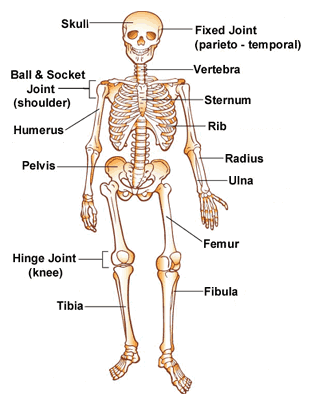
Bones serve three main functions in the body:
- Support
- Protection
- Movement
However, within the actual structure of several bones there is a substance called bone marrow in which there are cells that produce the red and white blood cells. The red blood cells circulate oxygen around the body.

White blood cells, also known as leukocytes, are the body's main defense against infection and disease. They are part of the immune system, circulating in the bloodstream and tissues to identify and eliminate harmful substances and pathogens.
How do muscles work?
Muscles work in conjunction with bones for motion in **antagonistic pairs** — as one contracts, the other relaxes. This allows joints to move in opposite directions.
Example – Biceps and triceps
When you bend your arm, the biceps contract and the triceps relax. When you straighten it, the triceps contract and the biceps relax.
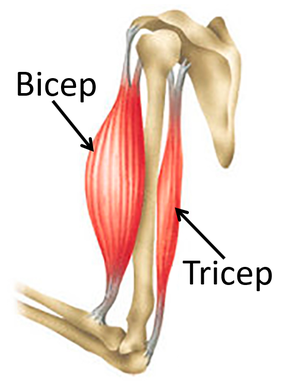
Ligaments, tendons and cartilage
The skeletal system needs to be fixed together and then connected to the muscles. The ligaments connect the bones to one another and the tendons connect the muscles to the bones via insertions into the bone. Cartilage, a durable elastic substance that helps to protect bones from knocking together.

Levers in the body
Bones act as **levers**, and joints act as **pivots (fulcrums)**. Muscles apply force to move bones around joints, following the principles of physics.
The position of the fulcrum affects how much force is needed to lift or move parts of the body.
The arm as a lever system
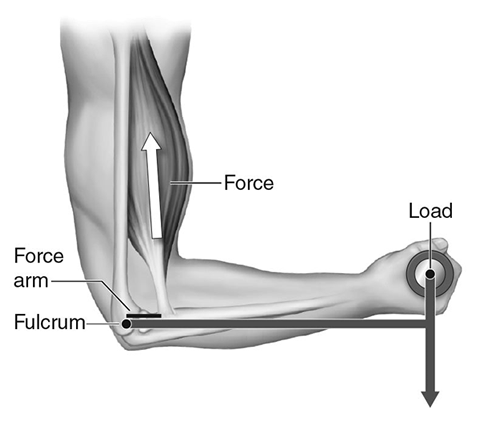
Lever investigation
Using a simple ruler and pivot setup, students explore how the position of the fulcrum changes the amount of effort needed to lift a load. Relate this to elbow and knee joints. Students can also model arm movement using string and cardboard bones.
Summary
- The musculoskeletal system enables movement and support
- Muscles work in pairs to move bones at joints
- Anaerobic respiration provides quick energy but creates lactic acid
- The body uses levers to move efficiently
Anaerobic respiration and lactic acid
When exercising hard, muscles may run low on oxygen and switch to **anaerobic respiration**, producing lactic acid.
Glucose → Lactic acid + Energy
This causes fatigue and soreness, but allows short bursts of intense activity.
Example – Sprinting
A sprinter uses anaerobic respiration to generate energy quickly during a 100m dash. Lactic acid builds up, causing the burning sensation in muscles.
Check your understanding
- What connects muscles to bones?
- What causes lactic acid to build up?
- How is the arm like a lever system?
10u7.7 – Biomechanics
In the previous lesson, we explored how bones and muscles work together as a system of levers. Now we take a deeper look at how scientists and athletes study movement — using **biomechanics**, the science of motion in living things.
What is biomechanics?
Biomechanics combines biology and physics to study how the body moves. It applies principles like force, acceleration, and leverage to explain and improve physical performance.
- Used in sports science, physiotherapy, and prosthetics
- Focuses on improving efficiency and preventing injury
- Applies Newton’s laws and lever systems to the human body
Forces in movement
When we run, jump, or throw, our muscles apply forces to generate motion. These forces must overcome gravity and friction. Efficient movement uses the smallest energy for the best result.
Example – Jumping
Jumping requires strong upward force from the legs to overcome gravity. The angle of the knees and arms affects the jump height and balance.
Technology in biomechanics
Modern tools like motion-capture cameras and force plates allow scientists and coaches to analyse movement in detail.
- Used to correct running techniques
- Helps design better footwear and sports gear
- Improves rehabilitation plans for injured athletes
Biomechanics analysis task
Students film or analyse someone walking, running, or jumping (live or via sports footage). Use slow motion or freeze frames to identify forces at play, body angles, and efficiency. They then annotate or present their findings to the class.
Summary
- Biomechanics applies physics to understand body movement
- Forces, levers, and balance all affect performance
- Technology helps analyse and improve movement
Check your understanding
- What is biomechanics and why is it useful?
- How does centre of mass affect balance?
- Give one way technology is used in sports biomechanics.
10u7.8 – Transpiration
In previous lessons, we examined how animals transport substances through the circulatory system. In this final lesson, we shift to plants — which also transport water and nutrients through specialised systems. We focus on a key process called transpiration.
What is transpiration?
Transpiration is the evaporation of water from the leaves of a plant. As water escapes from the leaf surface (usually through tiny openings called stomata), it pulls more water upward through the plant from the roots.
- Transpiration creates a suction force in xylem vessels
- This helps move water and dissolved minerals from roots to leaves
- Transpiration also cools the plant and maintains water flow
The transpiration stream
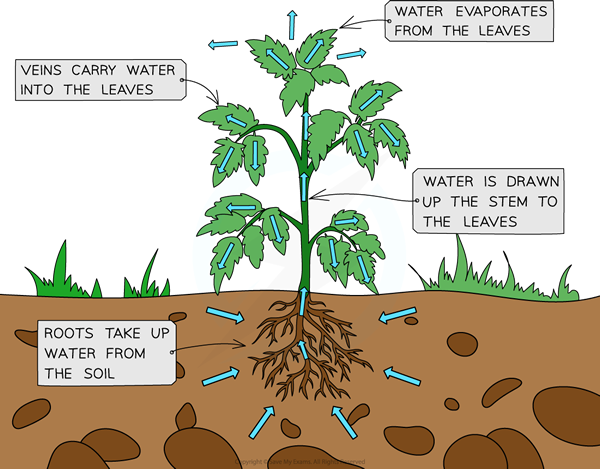
Osmosis and water movement
Water enters the plant roots by osmosis — the movement of water across a partially permeable membrane from a dilute solution to a more concentrated one.
Example – Osmosis in action
Place a de-shelled egg in corn syrup and watch water move out of the egg by osmosis, shrinking it. This models how osmosis draws water from soil into roots.
Water moves from the soil into the roots by osmosis

Stomata and regulation
Stomata are small pores on the underside of leaves that control gas exchange and water loss. They open in the day for photosynthesis and close at night or in dry conditions to reduce water loss.
Stomata under a microscope
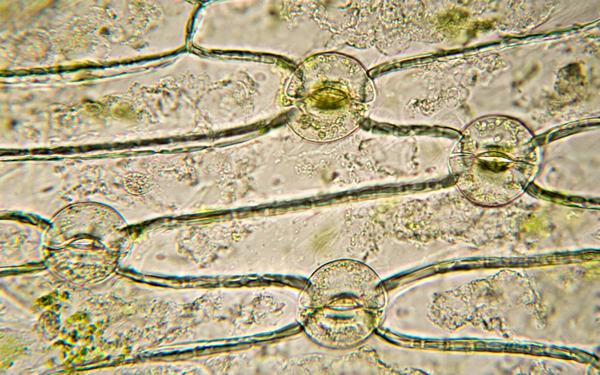
Photosynthesis and transpiration
Plants use sunlight to convert carbon dioxide and water into glucose and oxygen — this process is photosynthesis.
carbon dioxide + water → glucose + oxygen
6CO2 + 6H2O → C6H12O6 + 6O2
Photosynthesis
Transpiration ensures that water — a key reactant — is constantly supplied to the leaves.
Osmosis and transpiration experiment
Use the classic egg-in-syrup or potato in salt water to model osmosis. Alternatively, use a leafy stalk (e.g. celery or Chinese cabbage) in coloured water to observe how xylem draws up water through transpiration. Students record observations and explain how the plant moves water.
Summary
- Transpiration moves water from roots to leaves via xylem
- Osmosis draws water into the roots from the soil
- Stomata regulate water loss and gas exchange
- Water is essential for photosynthesis and plant cooling
Check your understanding
- What is transpiration, and why is it important for plants?
- How does osmosis help water enter a plant?
- Why do stomata close on hot, dry days?
10u7.9 - Now test yourself
Click on the button below to access the self-tests for MYP9 and MYP10.